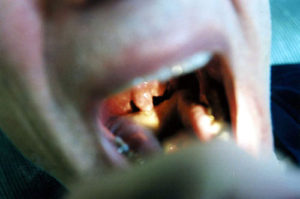
Research has long shown that Americans from minority groups and those with a lower socioeconomic status are less likely to get routine dental visits than patients who are white and more affluent. A new study finds that even when minorities or those who are poorer and less educated do receive oral health services, they are less likely to receive oral cancer (OC)screenings that could lead an early diagnosis.
The findings come at a time when oral cancer, which disproportionately burdens poorer, less-educated and minority patients, is on the rise, according to federal data.
Timely screening can save lives when it comes to treating OC, according to authors of the study published in the American Journal of Preventive Medicine.
“Early-stage OCs have significantly better five-year survival rates (82.8 percent) than those involving regional tissues/lymph nodes (50 percent) or those that have metastasized (28 percent). Therefore, early detection of OCs is highly desirable,” note the Brigham and Women’s Hospital (Boston) researchers, who used data from the National Health and Nutrition Examination Survey (NHANES). The ongoing federal survey tracks over time the health status of a nationally representative sampling of the U.S. civilian, non-institutionalized population.
Oral cancer screenings are quick and non-invasive, the study notes. An intraoral cancer exam typically requires the health care provider to pull on the patient’s tongue, sometimes wrapped in gauze, and feel under the tongue and inside the cheeks. For an extraoral cancer exam, the provider feels the patient’s neck.
Yet across all races and groups screening rates are low, with fewer than 38 percent of patients reporting that they received an intraoral cancer exam and fewer than 32 percent saying they had gotten an extraoral examination. The researchers identify “stark differences” among the population-level proportions of those screened. For example, while 46.5 percent of white patients reported receiving intraoral screenings, only 18. 6 percent of black, 16 percent of Asian and 10 percent of Mexican Americans reported receiving them, the study found.
The likelihood of screening also varied widely based on insurance status. While 44.1 percent of Medicare patients and 42.6 percent of privately insured patients reported receiving intraoral cancer screenings, just 15.2 percent of uninsured and 14.3 percent of Medicaid patients did.
More highly educated patients were far more likely to report being screened than those with lower educational attainment.
The study had limitations since it relied on self-reported data. But the conclusions offer evidence that the nation still falls short of an important population health goal in the Healthy People 2020 initiative. Even when at-risk patients get dental visits, they often are not receiving cancer screenings, explained study author Avni Gupta in an email.
“Why this is important is directly related to the goal of reducing health disparities in Healthy People 2020,” Gupta wrote. “One of the goals is to reduce oral cancer screening disparities and to increase early detection of oral cancer.”
“Findings from our paper suggest that this not just achievable by promoting access to dental care, where most of these screening happen,” she added. “But we need to address barriers to screening for those who do have access and visit a dental clinic.”







